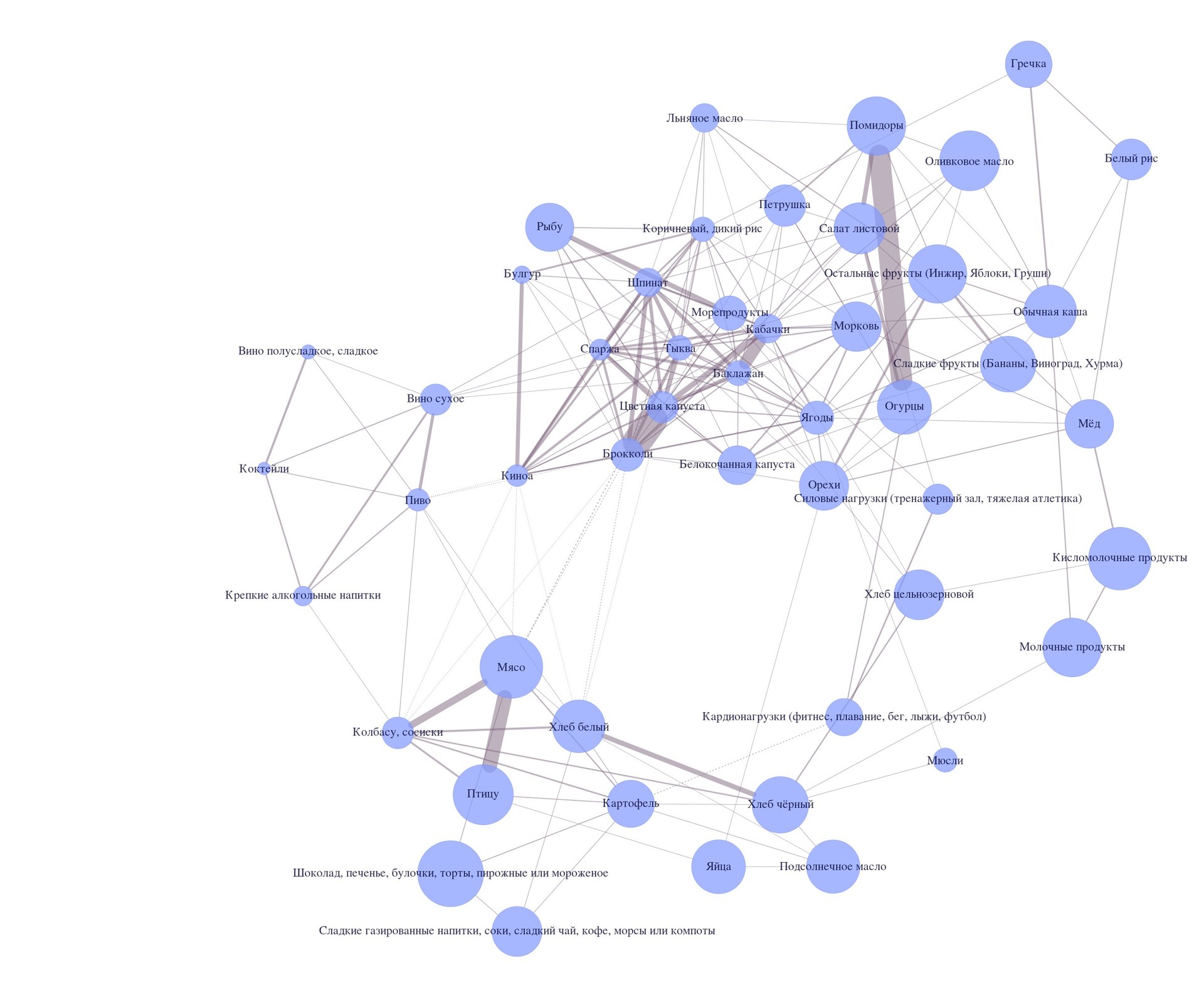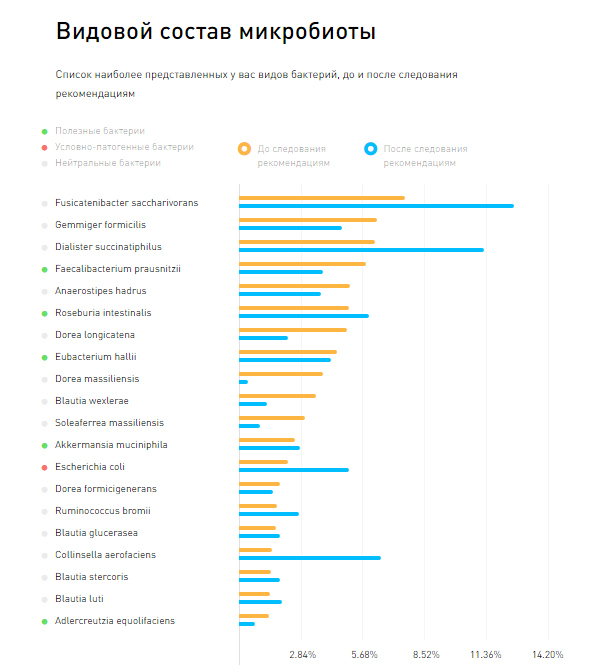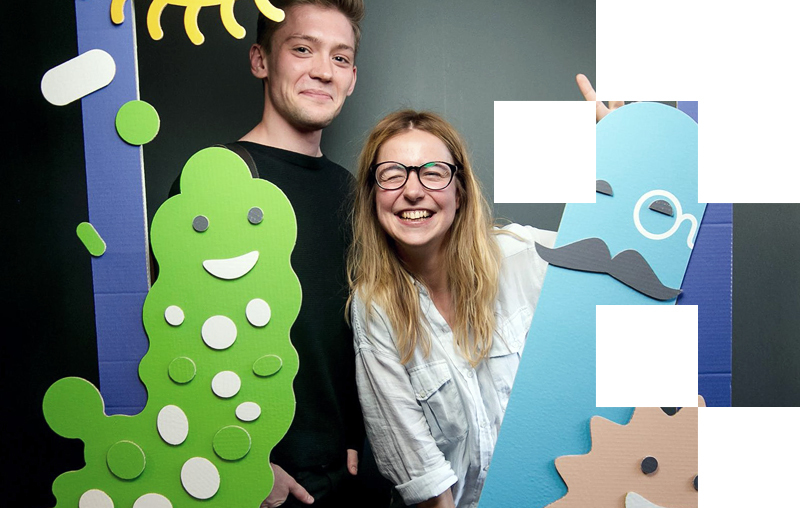The results of the first phase of the project OhmyGut
Atlas has already talked about our OhmyGut intestinal bacteria research project. In January, we launched crowdfunding on Bumstarter to begin research on the microbiota of the Russian population. It was the first case in Russia to find public funding for a biotechnological project - and it turned out to be successful.
After the end of the campaign at Bumstarter , we delivered two sets of OhmyGut dough to all participants. The idea was as follows: everyone passes the first analysis, then passes the questionnaire, receives recommendations on nutrition, follows them for two weeks and re-passes the test. As a result, we get 271 x 2 test tubes and tremendous material for testing scientific and marketing hypotheses.
Something like this happened, and now we will share the results.
')

Metagenomic sequencing is used to determine which microbial species and in which proportions inhabit the intestines. This technology reads the genomic sequences of microbes "as is", without prior division into groups and growing colonies in Petri dishes.
We used the simplest and cheapest method: not all genomes were read, but only one gene of each microbe several hundred letters long — namely, 16S rRNA. The cell uses this sequence to build the ribosome, the most important molecular machine necessary for protein synthesis.
The sequence of the 16S rRNA gene is unique for each species. Therefore, it is excellent for genotyping bacteria. The sequence is read using sequencers (the most expensive equipment in the whole process). The DNA extracted from the microbiota samples is fed into the input, the output is the data: thousands of reads for each sample. In our study, the average read weighed about 250 letters.
Here is what the Escherichia coli reed genome reed looks like:

It is possible to determine the species, genus or family of the bacterium by such a word thanks to a number of bacterial genomic studies. All data and scientific publications are compiled into the NCBI publicly available databases.
In general, the methods for studying the bacterial composition are similar to those used for the genetic test. Under laboratory conditions, we isolate the DNA of a separate part of the genome (16S rRNA in the case of microbiota) using special primers, then multiply the molecules obtained using protein polymerase, read them, obtain the reads and determine which bacteria and in what fractions are present in the sample. We analyze the data obtained, draw up a report and recommendations based on the results, upload it to your personal account. #everyone is happy.
In Russia, such studies for a wide range of users no one else offers. In the United States, the uBiome project, which conducts microbiota (and not only intestinal) tests, was launched several years ago. In Germany, the research project My Microbes is working, but so far this is not a commercial product, and participation in it costs about 600 euros. OhmyGut doesn't have any closer competitors.
Crowdfunding was not only beta testing OhmyGut as a future commercial product , but also scientific research. Nevertheless, there was no control group in it: we did not put forward any hypotheses, for testing which the “experiment-control” design might be required.
The sample “participants of crowdfunding on Bumstarter” is not representative - in the sense in which this concept is used in epidemiology. For our research, we did not select such Muscovites who would reflect statistics on Moscow. And although in our sample all three main enterotypes were represented, we cannot say that in a representative sample in Moscow or in Russia the ratio of these types will be the same. But “unrepresentative” does not mean “unscientific”.
We conducted a prospective intervention study, where the recommendations for nutrition were given as interventions, which we gave to participants after filling out the questionnaire. According to the results of our study, we estimated the influence of various factors on the composition of the microbiota, as well as the range of changes in the microbiota for those who changed and did not change their eating habits.
As an example of a study with a similar design, one can cite a project in which two groups were considered separately: vegetarians who began to eat meat, and meat-eaters who stopped eating meat and ate vegetable food.
In total, 271 people took part in the study, all of whom are Moscow residents. If you describe the average participant in the OhmyGut project, it will be a young man (29-31 years old) of normal physique (body mass index 21-23 at a rate of 19-25) who eats four times a day and sleeps 7-8 hours. He does sports several times a week (and prefers cardiovascular training to strength training) and hardly drinks at all - only a glass of dry wine several times a month. Perhaps we recognize ourselves or our friends in this portrait.
The diet of the average OhmyGut test is quite standard: meat, dairy and dairy products, potatoes and white bread several times a week and no flaxseed oil and quinoa (until our recommendations). In a word, nothing that we did not know about ourselves.
According to the results of the questionnaire, we made a graph and built links between products that are included in the usual diet of our participants. It was interesting to check the mathematical model of observations from life. Study participants only eat tomatoes with cucumbers; if in the diet there is meat, then there is a bird, zucchini are paired with eggplant, and cauliflower - with broccoli. On the graph you can see how the products are clustered in two types: conditionally vegetarian (upper right corner) and conditionally meat-eating (lower left).

We collected a database of microbiota composition and user metadata and a report for participants on 90+ pages. There are several sections in it: the composition of bacteria, the description of microbiota types, the level of protection from diseases, vitamin-genesis, butyrate synthesis of butyric acid, recommendations on products and prebiotics.



Thanks to our recommendations, some participants managed to increase the representation of beneficial bacteria, make the microbiota more balanced, and even change one cluster of microbiota to another. For example, from the third type with the predominant "Western" diet and fast food - into the second, more vegetarian.
Well, the most important success is the confirmation that an ordinary healthy person is ready to pass such a test. Even twice. Just to eat better. Impressive!
We will continue to work on the recommendations section. Now we provide a list of additional products that are good for bacteria and will increase their representation. It includes, for example, endive and Jerusalem artichoke - and we also removed the plantain leaves from the text (note to the hostess: they are useful).
At the same time, it is wrong to maintain exclusively colonies of intestinal bacteria and at the same time leave the human body itself without the main nutrients. We took into account this nuance and in the next iteration of the report we plan to introduce information on the basics of proper nutrition.
It remains for us to thank all the participants in the crowdfunding and return to work. Ahead of the second edition of the report, revised and augmented, the commercial launch of the test and integration with the data of the genetic test. In the meantime, you can take a breath and have some fun .

After the end of the campaign at Bumstarter , we delivered two sets of OhmyGut dough to all participants. The idea was as follows: everyone passes the first analysis, then passes the questionnaire, receives recommendations on nutrition, follows them for two weeks and re-passes the test. As a result, we get 271 x 2 test tubes and tremendous material for testing scientific and marketing hypotheses.
Something like this happened, and now we will share the results.
')

I was told a word, I spread it in a string
Metagenomic sequencing is used to determine which microbial species and in which proportions inhabit the intestines. This technology reads the genomic sequences of microbes "as is", without prior division into groups and growing colonies in Petri dishes.
We used the simplest and cheapest method: not all genomes were read, but only one gene of each microbe several hundred letters long — namely, 16S rRNA. The cell uses this sequence to build the ribosome, the most important molecular machine necessary for protein synthesis.
The sequence of the 16S rRNA gene is unique for each species. Therefore, it is excellent for genotyping bacteria. The sequence is read using sequencers (the most expensive equipment in the whole process). The DNA extracted from the microbiota samples is fed into the input, the output is the data: thousands of reads for each sample. In our study, the average read weighed about 250 letters.
Here is what the Escherichia coli reed genome reed looks like:

It is possible to determine the species, genus or family of the bacterium by such a word thanks to a number of bacterial genomic studies. All data and scientific publications are compiled into the NCBI publicly available databases.
In general, the methods for studying the bacterial composition are similar to those used for the genetic test. Under laboratory conditions, we isolate the DNA of a separate part of the genome (16S rRNA in the case of microbiota) using special primers, then multiply the molecules obtained using protein polymerase, read them, obtain the reads and determine which bacteria and in what fractions are present in the sample. We analyze the data obtained, draw up a report and recommendations based on the results, upload it to your personal account. #everyone is happy.
In Russia, such studies for a wide range of users no one else offers. In the United States, the uBiome project, which conducts microbiota (and not only intestinal) tests, was launched several years ago. In Germany, the research project My Microbes is working, but so far this is not a commercial product, and participation in it costs about 600 euros. OhmyGut doesn't have any closer competitors.
Representative sample and control group
Crowdfunding was not only beta testing OhmyGut as a future commercial product , but also scientific research. Nevertheless, there was no control group in it: we did not put forward any hypotheses, for testing which the “experiment-control” design might be required.
The sample “participants of crowdfunding on Bumstarter” is not representative - in the sense in which this concept is used in epidemiology. For our research, we did not select such Muscovites who would reflect statistics on Moscow. And although in our sample all three main enterotypes were represented, we cannot say that in a representative sample in Moscow or in Russia the ratio of these types will be the same. But “unrepresentative” does not mean “unscientific”.
What kind of enterotype is this?
An enterotype is a stable combination of bacterial species whose composition depends on the predominance of fiber, animal protein, or complex carbohydrates in the diet.
We conducted a prospective intervention study, where the recommendations for nutrition were given as interventions, which we gave to participants after filling out the questionnaire. According to the results of our study, we estimated the influence of various factors on the composition of the microbiota, as well as the range of changes in the microbiota for those who changed and did not change their eating habits.
As an example of a study with a similar design, one can cite a project in which two groups were considered separately: vegetarians who began to eat meat, and meat-eaters who stopped eating meat and ate vegetable food.
Who are the OhmyGut crowdfunding participants?
In total, 271 people took part in the study, all of whom are Moscow residents. If you describe the average participant in the OhmyGut project, it will be a young man (29-31 years old) of normal physique (body mass index 21-23 at a rate of 19-25) who eats four times a day and sleeps 7-8 hours. He does sports several times a week (and prefers cardiovascular training to strength training) and hardly drinks at all - only a glass of dry wine several times a month. Perhaps we recognize ourselves or our friends in this portrait.
And what do they eat
The diet of the average OhmyGut test is quite standard: meat, dairy and dairy products, potatoes and white bread several times a week and no flaxseed oil and quinoa (until our recommendations). In a word, nothing that we did not know about ourselves.
According to the results of the questionnaire, we made a graph and built links between products that are included in the usual diet of our participants. It was interesting to check the mathematical model of observations from life. Study participants only eat tomatoes with cucumbers; if in the diet there is meat, then there is a bird, zucchini are paired with eggplant, and cauliflower - with broccoli. On the graph you can see how the products are clustered in two types: conditionally vegetarian (upper right corner) and conditionally meat-eating (lower left).

What happened
We collected a database of microbiota composition and user metadata and a report for participants on 90+ pages. There are several sections in it: the composition of bacteria, the description of microbiota types, the level of protection from diseases, vitamin-genesis, butyrate synthesis of butyric acid, recommendations on products and prebiotics.



Thanks to our recommendations, some participants managed to increase the representation of beneficial bacteria, make the microbiota more balanced, and even change one cluster of microbiota to another. For example, from the third type with the predominant "Western" diet and fast food - into the second, more vegetarian.
Well, the most important success is the confirmation that an ordinary healthy person is ready to pass such a test. Even twice. Just to eat better. Impressive!
What did not work
We will continue to work on the recommendations section. Now we provide a list of additional products that are good for bacteria and will increase their representation. It includes, for example, endive and Jerusalem artichoke - and we also removed the plantain leaves from the text (note to the hostess: they are useful).
At the same time, it is wrong to maintain exclusively colonies of intestinal bacteria and at the same time leave the human body itself without the main nutrients. We took into account this nuance and in the next iteration of the report we plan to introduce information on the basics of proper nutrition.
What now
It remains for us to thank all the participants in the crowdfunding and return to work. Ahead of the second edition of the report, revised and augmented, the commercial launch of the test and integration with the data of the genetic test. In the meantime, you can take a breath and have some fun .

Source: https://habr.com/ru/post/395021/
All Articles